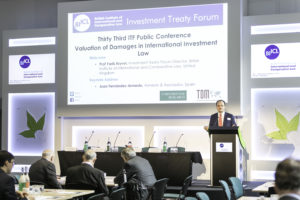On 18 October 2019, we organised a conference on the valuation of damages in international investment law. This topic is far from being theoretical as slight differences in the methodology of calculation of damages can lead to giant differences in sums awarded.
For example, in the controversial Tethyan v. Pakistan case earlier this year, Pakistan was ordered to pay nearly US$6 billion as compensation when one of its provinces denied a mining licence. The ICSID tribunal used a “modern DCF method” (never used by other tribunals before), despite ‘fundamental uncertainties’ regarding the future of the project.
The inconsistency of methodology of valuation of damages undermines the legitimacy of investor-state dispute settlement. Current international efforts to harmonize approaches to valuation of damages have so far a limited effect.
A few takeaways from the conference:
-
- Significant differences exist between valuation in investor-State disputes different from commercial arbitration. These differences reflect issues such as involvement of sovereigns, country risk premiums, and the social impact of different awards of damages.
- Proving damages is particularly challenging, as often tribunals deal with future profits and the word “proving” is hardly a good one to describe it.
- Quantification of damages leads to a whole set of other problems, such as differences between “full reparation,” “full compensation” and “fair market value”, other valuation standards. There is no agreement between tribunals on how to treat contributory negligence or moral damages.
- A number of differences arise because unline commercial arbitration awards, many investor-state awards are publicly available. However, investor-state arbitration is far from being completely transparent.
- Both in commercial and investor-state arbitration tribunals may find it difficult to distinguish between legal principles and economic analysis, which may have important consequences for the outcomes of cases.
- From the perspective of third-party funders, investment arbitration tends to be expensive because of the proceedings last longer. According to some estimates, average commercial arbitration lasts 2,5 years in commercial arbitration, compared 3.8 years in ICSID cases.
- The average cost of arbitration is $6m and $4.5m respectively. Another interesting distinction is that investment law disputes re far less likely to settle (in commercial – 60% are settled; around 30% are settled or discontinued).
- The discounted cash flow (DCF) method was used in approximately 60% of publically available cases in 2018.
- Often experts are overinstructed when it comes to damages which leads to a very large between investors and respondents.
- Compound interest remains the rule in ISDS (over 90%) unless otherwise stipulated in a relevant treaty or another instrument. Many these days, however, question the whole concept of the future value of money as many countries move to negative interest rates.
Prof Yarik Kryvoi
British Institute of International and Comparative Law




147 comments
Comments are closed.